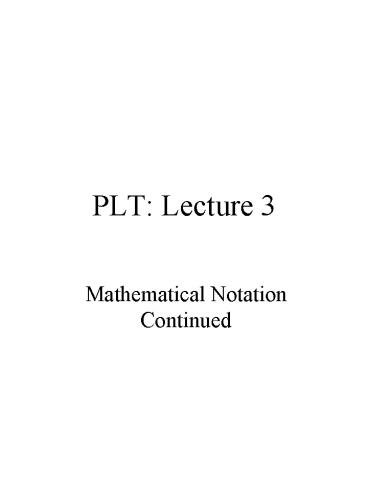PLT: Lecture 3 - PowerPoint PPT Presentation
1 / 14
Title: PLT: Lecture 3
1
PLT Lecture 3
- Mathematical Notation Continued
2
Last Lecture
- Outlined the need for compilation
- Outlined the requirements for compilation
- Sought a domain where they have experience with
these requirements - Started exploring this domain mathematical
notation - Its parts
- Their properties
3
Expression Trees
- Advantages
- Ease of reading
- Spaced out
- No need for decoding delimiters
- Spacing means space for annotations
- But they suffer from the word-processor
1-dimension problem - Often addressed by using images to portray
expressions. - This can lead to problems too
4
Maths as Images Problems
- Searching problems
- Re-use problems
- Display Problems
- Font size variations
- Resolution, emphasized when printed
- The halo effect (admittedly small)
- Horizontal alignment with text
- Bandwidth problems
5
1-D Notations
- Demarking first and last symbols in a
sub-expression - ( )
- lt gt
- Free to use which-ever you like in Mathematics
but not so in computer languages (C for e.g.) - Meanings of ( ) 4
- Meanings of 2
- Meanings of 5.5
6
Communication Issues
- In reading expressions in 1-D, identical
delimiters can cause problems - ( ((bb)-((4a)c)))/(2a)
- ( bb-lt4agtc)/(2a)
- See how easy it is when using stretchable
operators - (ab)/(cd)
- ( (ab))/(cd)
- ( ((ab)/(cd))
- ( ((ab)/(cd)) (d(d1))
7
Reducing the number of delimiter expressions
- The scoping issue
- Stretchable operators
- Piggy in the middle
- Prefix and postfix unary operator
- Binary infix operators
- 243
- What happens the 4
- If its the right operand of then 24 is the
left operand of 18 - If its the left operand of then 43 is the
right operant of 14 - More formally
- Priority
- Associativity
8
Priority
- If o1 has a greater priority than o2 then (for
binary infix ops) - a o1 b o2 c (a o1 b) o2 c
- a o2 b o1 c a o2 (b o1 c)
- This can only help so much in our effort to
minimize delimiters
9
Extending Priority for unary operators
- Scenario
- Unary prefix operator / unary postfix operator
- Unary prefix operator / binary infix operator
- Binary infix operator / unary prefix operator
- Latter 2 assume the unary operators have higher
precedence than binary ones - !altb (a1, b0)
10
Priorities / Associativity in C
- Associativity (a16, b4, c2)
- int a3
- int a-b-3
- (a5)(b8)(c2)
- a / b / c
- sizeof(sizeof(8))
- Priority (w1, x0, y6, z5)
- if(x!0)
- --j // illegal
- Data ptr
- ty / z w
- dataptry
11
Keywords in Programming Language Expressions
- Delimiters
- Algol 68 / Modula-2
- if..fi
- dood
- case.esac
- Operators
- ADD X TO Y GIVING Z
12
A Scheme for Generating Definitions of
Expressions
- Generic Rules
- Starter Rule
- Provide a starter set of expressions
- Complex Rules
- Build on the starter rules to provide a more
complex set of expressions - Uses 3 sets
- Literal symbols
- Variable symbols
- Punctuation symbols ( )
- Operator symbols with their arity, and fixity
13
Informal Structure
- Every literal symbol is an expression
- Every variable symbol is an expression
- Is E1 is an expression, then (E1) is an
expression - If o is a unary prefix operator and E1 is an
expression then oE1 is an expression - If o is a binary infix operator and E1, E2 are
expressions then E1 o E2 is an expression - If o is a unary postfix operator and E1 is an
expression then E1o is an expression - If o is a n-ary prefix operator and E1, E2En are
expressions then o(E1, E2En) is an expression - If o is a n-ary postfix operator and E1, E2En
are expressions then (E1, E2En)o is an
expression
14
mOn Notation
- Succinctly specifying arity and fixity
- 0O1
- 1O0
- 1O1
- 0On
- nO0
- Now we are in a better position to formalize the
scheme - We will do this in the next lecture































